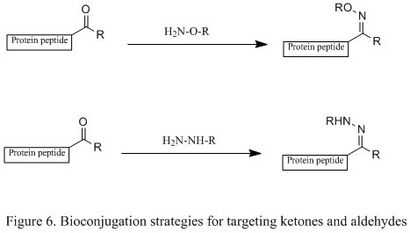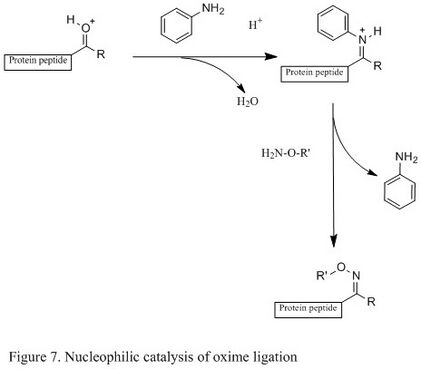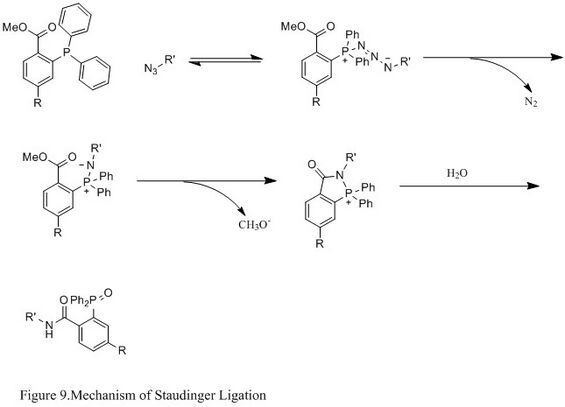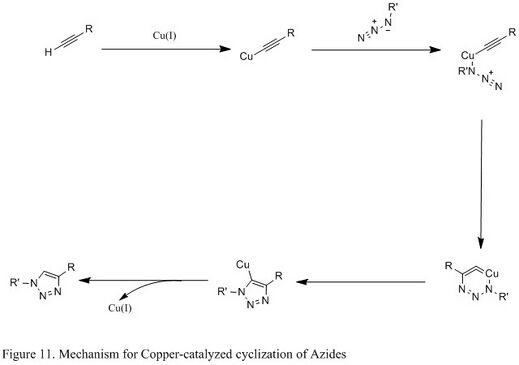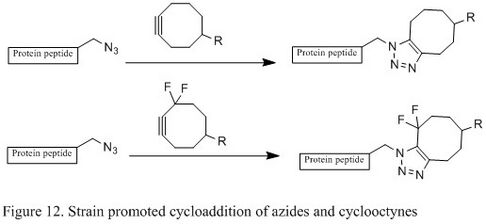Biology:Bioconjugation
Bioconjugation is a chemical strategy to form a stable covalent link between two molecules, at least one of which is a biomolecule.
Overview
Function
Recent advances in the understanding of biomolecules enabled their application to numerous fields like medicine and materials. Synthetically modified biomolecules can have diverse functionalities, such as tracking cellular events, revealing enzyme function, determining protein biodistribution, imaging specific biomarkers, and delivering drugs to targeted cells.[1][2][3][4] Bioconjugation is a crucial strategy that links these modified biomolecules with different substrates. Besides applications in biomedical research, bioconjugation has recently also gained importance in nanotechnology such as bioconjugated quantum dots.
Types of Conjugated Molecules
The most common types of bioconjugation include coupling of a small molecule (such as biotin or a fluorescent dye) to a protein. Antibody-drug conjugates such as Brentuximab vedotin and Gemtuzumab ozogamicin are examples falling into this category.[5]
Protein-protein conjugations, such as the coupling of an antibody to an enzyme, is also common in bioconjugations.[6]
Other less common molecules used in bioconjugation are oligosaccharides, nucleic acids, synthetic polymers such as polyethylene glycol,[7] and carbon nanotubes.[8]
Common Bioconjugation Reactions
Synthesis of bioconjugates involves a variety of challenges, ranging from the simple and nonspecific use of a fluorescent dye marker to the complex design of antibody drug conjugates.[1][3] Various bioconjugation reactions have been developed to chemically modify proteins. Common types of bioconjugation reactions on proteins are coupling of lysine, cysteine, and tyrosine amino acid residues, as well as modification of tryptophan residues and of the N- and C- terminus.[1][3][4]
However, these reactions often lack chemoselectivity and efficiency, because they depend on the presence of native amino acids, which are present in large quantities that hinder selectivity. There is an increasing need for chemical strategies that can effectively attach synthetic molecules site specifically to proteins. One strategy is to first install a unique functional group onto a protein, and then a bioorthogonal reaction is used to couple a biomolecule with this unique functional group.[1] The bioorthogonal reactions targeting non-native functional groups are widely used in bioconjugation chemistry. Some important reactions are modification of ketone and aldehydes, Staudinger ligation with organic azides, copper-catalyzed Huisgen cycloaddition of azides, and strain promoted Huisgen cycloaddition of azides.[9][10][11][12]
On Natural Amino Acids
Reactions of lysines
The nucleophilic lysine residue is commonly targeted site in protein bioconjugation, typically through amine-reactive N-hydroxysuccinimidyl (NHS) esters.[3] To obtain optimal number of deprotonated lysine residues, the pH of the aqueous solution must be below the pKa of the lysine ammonium group, which is around 10.5, so the typical pH of the reaction is about 8 and 9. The common reagent for the coupling reaction is NHS-ester (shown in the first reaction below in Figure 1), which reacts with nucleophilic lysine through a lysine acylation mechanism. Other similar reagents are isocyanates and isothiocyanates that undergo a similar mechanism (shown in the second and third reactions in Figure 1 below).[1] Benzoyl fluorides (shown in the last reaction below in Figure 1), which allows for lysine modification of proteins under mild conditions (low temperature, physiological pH), were recently proposed as an alternative to classically used lysine specific reagents.[13]
File:Bioconjugation strategies for lysine residues.tif
Reactions of cysteines
Because free cysteine rarely occurs on protein surface, it is an excellent choice for chemoselective modification.[14] Under basic condition, the cysteine residues will be deprotonated to generate a thiolate nucleophile, which will react with soft electrophiles, such as maleimides and iodoacetamides (shown in the first two reactions in Figure 2 below). As a result, a carbon-sulfur bond is formed. Another modification of cysteine residues involves the formation of disulfide bond (shown in the third reaction in Figure 2). The reduced cysteine residues react with exogenous disulfides, generating new a disulfide bond on the protein. An excess of disulfides is often used to drive the reaction, such as 2-thiopyridone and 3-carboxy-4-nitrothiophenol.[1][3] Electron-deficient alkynes were demonstrated to selectively react with cysteine residues of proteins in the presence of other nucleophilic amino acid residues. Depending on the alkyne substitution, these reactions can produce either cleavable (when alkynone derivatives are used),[15] or hydrolytically stable bioconjugates (when 3-arylpropiolonitriles are used; the last reaction below in Figure 2).[16]
File:Bioconjugation strategies for cysteine residues.tif
Reactions of tyrosines
Tyrosine residues are relatively unreactive; therefore they have not been a popular targets for bioconjugation. Recent development has shown that the tyrosine can be modified through electrophilic aromatic substitutions (EAS) reactions, and it is selective for the aromatic carbon adjacent to the phenolic hydroxyl group.[1] This becomes particularly useful in the case that cysteine residues cannot be targeted. Specifically, diazonium effectively couples with tyrosine residues (diazonium salt shown as reagent in the first reaction in Figure 3 below), and an electron withdrawing substituent in the 4-position of diazonium salt can effectively increase the efficiency of the reaction. Cyclic diazodicarboxyamide derivative like 4-Phenyl-1,2,4-triazole-3,5-dione (PTAD) were reported for selective bioconjugation on tyrosine residues (the second reaction in Figure 3 below).[17] A three-component Mannich-type reaction with aldehydes and anilines (the last reaction in Figure 3) was also described to be relatively tyrosine-selective under mild optimised reaction conditions.[18]
File:Bioconjugation strategies for tyrosine residues.tif
Reactions of N- and C- termini
Since natural amino acid residues are usually present in large quantities, it is often difficult to modify one single site. Strategies targeting the termini of protein have been developed, because they greatly enhanced the site selectivity of protein modification. One of the N- termini modifications involves the functionalization of the terminal amino acid. The oxidation of N-terminal serine and threonine residues are able to generate N-terminal aldehyde, which can undergo further bioorthogonal reactions (shown in the first reaction in Figure 4). Another type of modification involves the condensation of N-terminal cysteine with aldehyde, generating thiazolidine that is stable at high pH (second reaction in Figure 4). Using pyridoxal phosphate (PLP), several N-terminal amino acids can undergo transamination to yield N-terminal aldehyde, such as glycine and aspartic acid (third reaction in Figure 4).
File:Figure 4. Bioconjugation strategies for N-terminus.tif
An example of C-termini modification is the native chemical ligation (NCL), which is the coupling between a C-terminal thioester and a N-terminal cysteine (Figure 5).
File:Figure 5. Bioconjugation strategies for C-terminus.tif
Bioorthogonal Reactions: On Unique Functional Groups
Modification of ketones and aldehydes
A ketone or aldehyde can be attached to a protein through the oxidation of N-terminal serine residues or transamination with PLP. Additionally, they can be introduced by incorporating unnatural amino acids via the Tirrell method or Schultz method.[9] They will then selectively condense with an alkoxyamine and a hydrazine, producing oxime and hydrazone derivatives (shown in the first and second reactions, respectively, in Figure 6). This reaction is highly chemoselective in terms of protein bioconjugation, but the reaction rate is slow. The mechanistic studies show that the rate determining step is the dehydration of tetrahedral intermediate, so a mild acidic solution is often employed to accelerate the dehydration step.[2]
The introduction of nucleophilic catalyst can significantly enhance reaction rate (shown in Figure 7). For example, using aniline as a nucleophilic catalyst, a less populated protonated carbonyl becomes a highly populated protonated Schiff base.[19] In other words, it generates a high concentration of reactive electrophile. The oxime ligation can then occur readily, and it has been reported that the rate increased up to 400 times under mild acidic condition.[19] The key of this catalyst is that it can generate a reactive electrophile without competing with desired product.
Recent developments that exploit proximal functional groups have enabled hydrazone condensations[20] to operate at 20 M−1s−1 at neutral pH while oxime condensations have been discovered which proceed at 500-10000 M−1s−1 at neutral pH without added catalysts.[21][22]
Staudinger ligation with azides
The Staudinger ligation of azides and phosphine has been used extensively in field of chemical biology. Because it is able to form a stable amide bond in living cells and animals, it has been applied to modification of cell membrane, in vivo imaging, and other bioconjugation studies.[23][24][25][26]
Contrasting with the classic Staudinger reaction, Staudinger ligation is a second order reaction in which the rate-limiting step is the formation of phosphazide (specific reaction mechanism shown in Figure 9). The triphenylphosphine first reacts with the azide to yield an azaylide through a four-membered ring transition state, and then an intramolecular reaction leads to the iminophosphorane intermediate, which will then give the amide-linkage under hydrolysis.[27]
Huisgen cyclization of azides
Copper catalyzed Huisgen cyclization of azides
Azide has become a popular target for chemoselective protein modification, because they are small in size and have a favorable thermodynamic reaction potential. One such azide reactions is the [3+2] cycloaddition reaction with alkyne, but the reaction requires high temperature and often gives mixtures of regioisomers.
An improved reaction developed by chemist Karl Barry Sharpless involves the copper (I) catalyst, which couples azide with terminal alkyne that only give 1,4 substituted 1,2,3 triazoles in high yields (shown below in Figure 11). The mechanistic study suggests a stepwise reaction.[12] The Cu (I) first couples with acetylenes, and then it reacts with azide to generate a six-membered intermediate. The process is very robust that it occurs at pH ranging from 4 to 12, and copper (II) sulfate is often used as a catalyst in the presence of a reducing agent.[12]
Strain promoted Huisgen cyclization of azides
Even though Staudinger ligation is a suitable bioconjugation in living cells without major toxicity, the phosphine's sensitivity to air oxidation and its poor solubility in water significantly hinder its efficiency. The copper(I) catalyzed azide-alkyne coupling has reasonable reaction rate and efficiency under physiological conditions, but copper poses significant toxicity and sometimes interferes with protein functions in living cells. In 2004, chemist Carolyn R. Bertozzi's lab developed a metal free [3+2] cycloaddition using strained cyclooctyne and azide. Cyclooctyne, which is the smallest stable cycloalkyne, can couple with azide through [3+2] cycloaddition, leading to two regioisomeric triazoles (Figure 12).[10] The reaction occurs readily at room temperature and therefore can be used to effectively modify living cells without negative effects. It has also been reported that the installation of fluorine substituents on a cyclic alkyne can greatly accelerate the reaction rate.[2][28]
Transition Metal-Mediated Bioconjugation Reactions
Transition metal-based bioconjugation had been challenging due to the nature of biological conditions – aqueous solution, room temperature, mild pH, and low substrate concentrations – which are generally challenging for organometallic reactions. However, recently, besides copper-catalyzed [3 + 2] azide alkyne cycloaddition reaction, more and more diverse transition metal-mediated chemical transformations have been applied for bioconjugation reactions, introducing olefin metathesis, alkylation, C–H arylation, C–C, C–S, and C–N cross-coupling reactions.[29][30]
Alkylation
On Natural Amino Acids
Using in situ generated RhII-carbenoid by activation of vinyl-substituted diazo compounds with Rh2(OAc)4, tryptophans and cysteines were shown to be selectively alkylated in aqueous media.
However, this method is limited to surface tryptophans and cysteines possibly because of steric constraints.[33]
- Ir-catalyzed Lys and N-terminus (reductive) alkylation[34]
Imines formed from the condensation of aldehydes with lysines or the N-terminus can be reduced efficient by an water-stable [Cp*Ir(bipy)(H2O)]SO4 complex in the presence of formate ions (serving as the hydride source). The reaction happens readily under physiologically relevant conditions and results in high conversion for various aromatic aldehydes.
- Pd-catalyzed Tyr O-alkylation[35]
By using a pre-formed electrophilic π-allylpalladium(II) reagent derived from allylic acetate or carbamate precursors, selective allylic alkylation of tyrosines can be achieved in aqueous solution at room temperature and in the presence of cysteines.
- Au-catalyzed Cys alkylation[36]
Cysteine-containing peptides have been shown to undergo 1,2-addition to allenes in the presence of gold(I) and/or silver(I) salts, producing hydroxyl substituted vinyl thioethers. The reaction with peptides proceeds with high yields and is selective for cysteines over other nucleophilic residues.
However, the reactivity towards proteins is much decreased, potentially due to the coordination of gold to the protein backbone.
Arylation
On Natural Amino Acids
- Trp arylation
Multiple methods have been reported to achieve tryptophan C–H arylation, where diverse electrophiles such as aryl halides[37][38] and aryl boronic acids[39] (an example shown below) have been used to transfer the aryl groups.
However, current tryptophan C–H arylation reaction conditions remain relatively harsh, requiring organic solvents, low pH and/or high temperatures.
- Cys arylation
Free thiols has been considered unfavorable for Pd-mediated reactions due to Pd-catalyst decomposition.[40] However, PdII oxidative addition complexes (OACs) supported by dialkylbiaryl phosphine ligands have shown to work efficiently towards cysteine S-arylation.
The first example is the use of PdII OAC with RuPhos:[41] The PdII complex resulting from the oxidative addition of aryl halides or trifluoromethanesulfonates and using RuPhos as the ligand could chemoselectively modify cysteines in various buffer with 5% organic co-solvent under neutral pH. This method has been shown to modify peptides and proteins, achieve peptide macrocyclization (by using bis-palladium reagent and peptides with two unprotected cysteines)[42] and synthesizing antibody-drug conjugates (ADCs). Changing the ligand to sSPhos supports the PdII complex to be sufficiently water soluble to achieve cysteine S-arylation under cosolvent-free aqueous conditions.[43]
There are other applications of this method where the PdII complexes were generated as PdII-peptide OACs by introducing 4-halophenylalanine into peptides during SPPS to achieve peptide-peptide or peptide-protein ligation.[44]
Alternate to directly oxidative addition to the peptide, the Pd OACs could also be transferred to the protein through amine-selective acylation reaction via NHS ester. The latter has been applied to selectively label surface lysine residues of a protein (forming PdII-protein OACs) and oligonucleotides (forming PdII-oligonucleotide OACs), which could then be linked to cysteine-containing peptides or proteins.[45]
Another example of protein-protein cross-coupling is achieved through converting cysteine residues into an electrophilic S-aryl–Pd–X OAC by utilizing an intramolecular oxidative addition strategy.[46]
- Lys arylation[47]
Similar to cysteine, lysine N-arylation could be achieved through Pd OACs with different dialkylbiaryl phosphine ligands. Due to weaker nucleophilicity and slower reductive elimination rate compared to cysteine, the selection of supporting ligands is shown to be critical. The bulky BrettPhos and t-BuBrettPhos ligands in conjunction with mildly basic sodium phenoxide have been used as the strategy to functionalize lysines on peptide substrates. The reaction happens in mild conditions and is selective over most other nucleophilic amino acid residues.
On Unnatural Amino Acids
Pd-mediated Sonogashira, Heck, and Suzuki-Miyaura cross-coupling reactions have been applied widely to modify peptides and proteins, where diverse Pd reagents have been developed for the application in aqueous solutions.[48] Those reactions require the protein or peptide substrate bearing unnatural functional groups such as alkyne,[49][50][51] aryl halides,[52][53][54][55] and aryl boronic acids,[56] which can be achieved through genetic code expansion or post-translational modifications.
Examples of Applied Bioconjugation Techniques
Growth Factors
Bioconjugation of TGF-β to iron oxide nanoparticles and its activation through magnetic hyperthermia in-vitro has been reported.[57] This was done by using 1-(3-dimethylaminopropyl)ethylcarbodiimide combined with N-Hydroxysuccinimide to form primary amide bonds with the free primary amines on the growth factor. Carbon nanotubes have been successfully used in conjunction with bioconjugation to link TGF-β followed by an activation with near-infrared light.[58] Typically, these reactions have involved the use of a crosslinker, but some of these add molecular space between the compound of interest and base material and in turn causes higher degrees of non-specific binding and unwanted reactivity.[59]
See also
- Immunofluorescence
- Biomolecular engineering
- Biotinylation
- SpyTag/SpyCatcher
- Unnatural amino acids
- Bioconjugate Chemistry journal
References
- ↑ 1.0 1.1 1.2 1.3 1.4 1.5 1.6 "Choosing an effective protein bioconjugation strategy". Nature Chemical Biology 7 (12): 876–884. November 2011. doi:10.1038/nchembio.720. PMID 22086289.
- ↑ 2.0 2.1 2.2 "Proteins: Chemistry and Chemical Reactivity". Wiley Encyclopedia of Chemical Biology. 2008. pp. 1–16. doi:10.1002/9780470048672.wecb493. ISBN 978-0470048672.
- ↑ 3.0 3.1 3.2 3.3 3.4 "New frontiers in protein bioconjugation". Current Opinion in Chemical Biology 14 (6): 771–773. December 2010. doi:10.1016/j.cbpa.2010.11.006. PMID 21112236.
- ↑ 4.0 4.1 "Advances in Bioconjugation". Current Organic Chemistry 14 (2): 138–147. January 2010. doi:10.2174/138527210790069839. PMID 20622973.
- ↑ "Antibody drug-conjugates targeting the tumor vasculature: Current and future developments". mAbs 1 (3): 247–253. 2009. doi:10.4161/mabs.1.3.8515. PMID 20069754. PMC 2726597. https://www.landesbioscience.com/journals/mabs/article/8515/.
- ↑ "Developments and recent advancements in the field of endogenous amino acid selective bond forming reactions for bioconjugation". Chemical Society Reviews 44 (15): 5495–5551. August 2015. doi:10.1039/C5CS00048C. PMID 26000775.
- ↑ "Well-defined protein-polymer conjugates--synthesis and potential applications". Applied Microbiology and Biotechnology 73 (2): 243–254. November 2006. doi:10.1007/s00253-006-0574-4. PMID 17061132. https://archive-ouverte.unige.ch/unige:7725.
- ↑ "Carbon nanotubes for biological and biomedical applications". Nanotechnology 18 (41): 412001. 2007. doi:10.1088/0957-4484/18/41/412001. Bibcode: 2007Nanot..18O2001Y.
- ↑ 9.0 9.1 "Introducing genetically encoded aldehydes into proteins". Nature Chemical Biology 3 (6): 321–322. June 2007. doi:10.1038/nchembio878. PMID 17450134.
- ↑ 10.0 10.1 "A strain-promoted [3 + 2] azide-alkyne cycloaddition for covalent modification of biomolecules in living systems". Journal of the American Chemical Society 126 (46): 15046–15047. November 2004. doi:10.1021/ja044996f. PMID 15547999.
- ↑ "Click Chemistry: Diverse Chemical Function from a Few Good Reactions". Angewandte Chemie 40 (11): 2004–2021. June 2001. doi:10.1002/1521-3773(20010601)40:11<2004::AID-ANIE2004>3.0.CO;2-5. PMID 11433435.
- ↑ 12.0 12.1 12.2 "A stepwise huisgen cycloaddition process: copper(I)-catalyzed regioselective "ligation" of azides and terminal alkynes". Angewandte Chemie 41 (14): 2596–2599. July 2002. doi:10.1002/1521-3773(20020715)41:14<2596::AID-ANIE2596>3.0.CO;2-4. PMID 12203546.
- ↑ "Acyl Fluorides: Fast, Efficient, and Versatile Lysine-Based Protein Conjugation via Plug-and-Play Strategy". Bioconjugate Chemistry 28 (5): 1452–1457. May 2017. doi:10.1021/acs.bioconjchem.7b00141. PMID 28443656.
- ↑ "Occurrence, conformational features and amino acid propensities for the pi-helix". Protein Engineering 15 (5): 353–358. May 2002. doi:10.1093/protein/15.5.353. PMID 12034854.
- ↑ "Electron-deficient alkynes as cleavable reagents for the modification of cysteine-containing peptides in aqueous medium". Chemistry: A European Journal 15 (15): 3839–3850. 2009. doi:10.1002/chem.200800669. PMID 19229937.
- ↑ "Selective irreversible chemical tagging of cysteine with 3-arylpropiolonitriles". Bioconjugate Chemistry 25 (2): 202–206. February 2014. doi:10.1021/bc400469d. PMID 24410136.
- ↑ "Facile and stabile linkages through tyrosine: bioconjugation strategies with the tyrosine-click reaction". Bioconjugate Chemistry 24 (4): 520–532. April 2013. doi:10.1021/bc300665t. PMID 23534985.
- ↑ "A three-component Mannich-type reaction for selective tyrosine bioconjugation". Journal of the American Chemical Society 126 (49): 15942–15943. December 2004. doi:10.1021/ja0439017. PMID 15584710.
- ↑ 19.0 19.1 "Nucleophilic catalysis of oxime ligation". Angewandte Chemie 45 (45): 7581–7584. November 2006. doi:10.1002/anie.200602877. PMID 17051631.
- ↑ "Fast hydrazone reactants: electronic and acid/base effects strongly influence rate at biological pH". Journal of the American Chemical Society 135 (47): 17663–17666. November 2013. doi:10.1021/ja407407h. PMID 24224646.
- ↑ "Dialdehydes lead to exceptionally fast bioconjugations at neutral pH by virtue of a cyclic intermediate". Angewandte Chemie 53 (41): 10928–10931. October 2014. doi:10.1002/anie.201406132. PMID 25164607.
- ↑ "Boronic acids facilitate rapid oxime condensations at neutral pH". Chemical Science 6 (6): 3329–3333. June 2015. doi:10.1039/C5SC00921A. PMID 29142692.
- ↑ "A fluorogenic dye activated by the staudinger ligation". Journal of the American Chemical Society 125 (16): 4708–4709. April 2003. doi:10.1021/ja029013y. PMID 12696879.
- ↑ "In vivo imaging of membrane-associated glycans in developing zebrafish". Science 320 (5876): 664–667. May 2008. doi:10.1126/science.1155106. PMID 18451302. Bibcode: 2008Sci...320..664L.
- ↑ "Cell surface engineering by a modified Staudinger reaction". Science 287 (5460): 2007–2010. March 2000. doi:10.1126/science.287.5460.2007. PMID 10720325. Bibcode: 2000Sci...287.2007S.
- ↑ "Chemical remodelling of cell surfaces in living animals". Nature 430 (7002): 873–877. August 2004. doi:10.1038/nature02791. PMID 15318217. Bibcode: 2004Natur.430..873P.
- ↑ "Mechanistic investigation of the staudinger ligation". Journal of the American Chemical Society 127 (8): 2686–2695. March 2005. doi:10.1021/ja044461m. PMID 15725026.
- ↑ "Copper-free click chemistry in living animals". Proceedings of the National Academy of Sciences of the United States of America 107 (5): 1821–1826. February 2010. doi:10.1073/pnas.0911116107. PMID 20080615.
- ↑ "Transition-Metal-Mediated Modification of Biomolecules". Chemistry: A European Journal 26 (44): 9792–9813. August 2020. doi:10.1002/chem.202001287. PMID 32602145.
- ↑ "Organometallic chemical biology: an organometallic approach to bioconjugation" (in en). Pure and Applied Chemistry 89 (11): 1619–1640. 2017-11-01. doi:10.1515/pac-2017-0207. ISSN 1365-3075.
- ↑ "Selective tryptophan modification with rhodium carbenoids in aqueous solution". Journal of the American Chemical Society 126 (33): 10256–10257. August 2004. doi:10.1021/ja047272c. PMID 15315433.
- ↑ "Rhodium-catalyzed cysteine modification with diazo reagents". Chemical Communications 49 (39): 4166–4168. May 2013. doi:10.1039/c2cc37323h. PMID 23175246.
- ↑ "Intermetallics J. Am. Chem. Soc. 1996, 118, 934". Journal of the American Chemical Society 118 (43): 10678. 1996-01-01. doi:10.1021/ja965445v. ISSN 0002-7863. http://dx.doi.org/10.1021/ja965445v.
- ↑ "Reductive alkylation of proteins using iridium catalyzed transfer hydrogenation". Journal of the American Chemical Society 127 (39): 13490–13491. October 2005. doi:10.1021/ja054686c. PMID 16190700.
- ↑ "Tyrosine-selective protein alkylation using pi-allylpalladium complexes". Journal of the American Chemical Society 128 (4): 1080–1081. February 2006. doi:10.1021/ja057106k. PMID 16433516.
- ↑ "Gold-mediated selective cysteine modification of peptides using allenes". Chemical Communications 49 (14): 1428–1430. February 2013. doi:10.1039/c2cc38214h. PMID 23322001.
- ↑ "Postsynthetic modification of peptides: chemoselective C-arylation of tryptophan residues". Chemistry: A European Journal 16 (4): 1124–1127. January 2010. doi:10.1002/chem.200902676. PMID 20013969.
- ↑ "Bioorthogonal Diversification of Peptides through Selective Ruthenium(II)-Catalyzed C-H Activation". Angewandte Chemie 56 (6): 1576–1580. February 2017. doi:10.1002/anie.201609631. PMID 28074503.
- ↑ "A mild and selective Pd-mediated methodology for the synthesis of highly fluorescent 2-arylated tryptophans and tryptophan-containing peptides: a catalytic role for Pd(0) nanoparticles?". Chemical Communications 50 (23): 3052–3054. March 2014. doi:10.1039/C3CC48481E. PMID 24516861.
- ↑ "Chemoselective Pd(0)-catalyzed peptide coupling in water". Organic Letters 3 (16): 2509–2511. August 2001. doi:10.1021/ol016169e. PMID 11483047.
- ↑ "Organometallic palladium reagents for cysteine bioconjugation". Nature 526 (7575): 687–691. October 2015. doi:10.1038/nature15739. PMID 26511579.
- ↑ "Divergent unprotected peptide macrocyclisation by palladium-mediated cysteine arylation". Chemical Science 8 (6): 4257–4263. June 2017. doi:10.1039/C6SC05454D. PMID 29081961.
- ↑ "Water-Soluble Palladium Reagents for Cysteine S-Arylation under Ambient Aqueous Conditions". Organic Letters 19 (16): 4263–4266. August 2017. doi:10.1021/acs.orglett.7b01911. PMID 28777001.
- ↑ "Palladium-peptide oxidative addition complexes for bioconjugation". Chemical Science 13 (40): 11891–11895. October 2022. doi:10.1039/D2SC04074C. PMID 36320916.
- ↑ "Oligonucleotide Bioconjugation with Bifunctional Palladium Reagents". Angewandte Chemie 60 (21): 12109–12115. May 2021. doi:10.1002/anie.202103180. PMID 33730425.
- ↑ "Protein-Protein Cross-Coupling via Palladium-Protein Oxidative Addition Complexes from Cysteine Residues". Journal of the American Chemical Society 142 (20): 9124–9129. May 2020. doi:10.1021/jacs.0c03143. PMID 32364380.
- ↑ "Palladium-Mediated Arylation of Lysine in Unprotected Peptides". Angewandte Chemie 56 (12): 3177–3181. March 2017. doi:10.1002/anie.201611202. PMID 28206688.
- ↑ "Moving Pd-mediated protein cross coupling to living systems". ChemBioChem 13 (12): 1728–1731. August 2012. doi:10.1002/cbic.201200353. PMID 22764130.
- ↑ "Ligand-free palladium-mediated site-specific protein labeling inside gram-negative bacterial pathogens". Journal of the American Chemical Society 135 (19): 7330–7338. May 2013. doi:10.1021/ja402424j. PMID 23641876.
- ↑ "Copper-free Sonogashira cross-coupling for functionalization of alkyne-encoded proteins in aqueous medium and in bacterial cells". Journal of the American Chemical Society 133 (39): 15316–15319. October 2011. doi:10.1021/ja2066913. PMID 21899368.
- ↑ "A genetically encoded alkyne directs palladium-mediated protein labeling on live mammalian cell surface". ACS Chemical Biology 10 (2): 379–384. February 2015. doi:10.1021/cb500649q. PMID 25347611.
- ↑ "A convenient catalyst for aqueous and protein Suzuki-Miyaura cross-coupling". Journal of the American Chemical Society 131 (45): 16346–16347. November 2009. doi:10.1021/ja907150m. PMID 19852502.
- ↑ "Palladium-mediated site-selective Suzuki-Miyaura protein modification at genetically encoded aryl halides". Chemical Communications 47 (6): 1698–1700. February 2011. doi:10.1039/C0CC04970K. PMID 21206952.
- ↑ "Palladium-mediated cell-surface labeling". Journal of the American Chemical Society 134 (2): 800–803. January 2012. doi:10.1021/ja209352s. PMID 22175226.
- ↑ "Self-liganded Suzuki-Miyaura coupling for site-selective protein PEGylation". Angewandte Chemie 52 (14): 3916–3921. April 2013. doi:10.1002/anie.201208626. PMID 23440916.
- ↑ "A genetically encoded boronate-containing amino acid". Angewandte Chemie 47 (43): 8220–8223. 2008-10-13. doi:10.1002/anie.200803240. PMID 18816552.
- ↑ "Carbodiimide Conjugation of Latent Transforming Growth Factor β1 to Superparamagnetic Iron Oxide Nanoparticles for Remote Activation". International Journal of Molecular Sciences 20 (13): 3190. June 2019. doi:10.3390/ijms20133190. PMID 31261853.
- ↑ "Carbon nanotube-assisted optical activation of TGF-β signalling by near-infrared light". Nature Nanotechnology 10 (5): 465–471. May 2015. doi:10.1038/nnano.2015.28. PMID 25775150. Bibcode: 2015NatNa..10..465L.
- ↑ "Effect of the spacer arm on non-specific binding in membrane affinity chromatography". MRS Communications 8 (1): 65–70. 2018. doi:10.1557/mrc.2018.4.
 |
